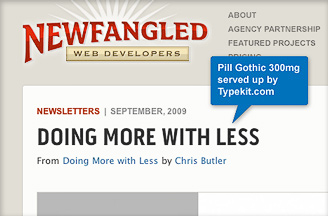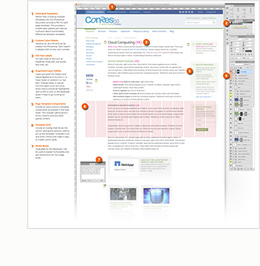Last month I stated my new year’s wish was a better selection of fonts for web design — and it looks like that may be closer to coming true.
During the development of our new site, I was reading about the capability of all major browsers to link to custom fonts on a remote server and embed them on your site by using CSS. This meant you could use something other than Verdana, Arial or Times to style your content. This would open the door to some great design possibilities that, up to now, were only available in print design. Sure, you could create a graphic for custom text (like a headline) but it wouldn’t be editable through a CMS or searchable by Google. sIFR technology offered to remedy the edibility and search issues but trapped content behind a combination of flash and javascript. The one hurdle to embedding custom fonts was licensing. Type designers spend hundreds of hours developing fonts and, like the rest of us, should be compensated for their work.
Typekit was developed in 2008 by Jeffrey Veen, Bryan Mason, Greg Veen, and Ryan Carver. They built a technology platform that hosts both free and commercial fonts in a way that is incredibly fast, smoothes out differences in how browsers handle type, and offers the level of protection that type designers need without resorting to annoying and ineffective DRM (digital rights management).
 There are hundreds of sites that already use the Typekit service so I decided to try it out on our new site. I’m conservative by nature so I didn’t want to risk more than one text element per page failing. The new-and-improved newfangled.com has been up and running for several weeks now and I’m pleased to say that our page headers look great and load without a hitch (in case you’re wondering, the font is called Pill Gothic 300mg).
There are hundreds of sites that already use the Typekit service so I decided to try it out on our new site. I’m conservative by nature so I didn’t want to risk more than one text element per page failing. The new-and-improved newfangled.com has been up and running for several weeks now and I’m pleased to say that our page headers look great and load without a hitch (in case you’re wondering, the font is called Pill Gothic 300mg).
I’m thankful that Typekit has helped make my new year’s wish come true. I wonder if they could help me out with the 1981 Honda CB900 Custom I’ve had my eye on…
FontCast #1 — Webfonts Week: Bryan Mason of Typekit from FontShop on Vimeo.
